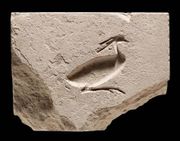Difference between revisions of "Intaglio"
(username removed) |
|||
| (2 intermediate revisions by 2 users not shown) | |||
| Line 1: | Line 1: | ||
| − | [[File:2002.633.7-SC63484.jpg|thumb| | + | [[File:2002.633.7-SC63484.jpg|thumb|Multi-plate color intaglio print<br>MFA# 2002.633.7]] |
== Description == | == Description == | ||
| − | + | [[File:Image3_802431.jpg|thumb|Egyptian printing block<br>MFA# 31.783a-b]] | |
| − | 1) One of the basic types of printing processes that includes engraving, etching, mezzotint and drypoint. For intaglio prints, the pattern is cut or etched into the surface of a woodblock or metal plate. The incised pattern is filled with ink, the excess ink wiped away, then the plate or block is pressed onto the paper. Thus lines are produced as a raised region of ink that is susceptible to abrasion. Intaglio uses either solvent or water based inks that tend to be pasty and tacky but nonelastic. Some of the inks may bleed. | + | 1) One of the basic types of printing processes that includes [[engraving]], [[etching]], [[mezzotint]] and [[drypoint]]. For intaglio prints, the pattern is cut or etched into the surface of a woodblock or metal plate. The incised pattern is filled with ink, the excess ink wiped away, then the plate or block is pressed onto the paper. Thus lines are produced as a raised region of ink that is susceptible to abrasion. Intaglio uses either solvent or water based inks that tend to be pasty and tacky but nonelastic. Some of the inks may bleed. |
2) A darkened watermark on paper. The shadow design of an intaglio watermark is made with thicker, denser regions. | 2) A darkened watermark on paper. The shadow design of an intaglio watermark is made with thicker, denser regions. | ||
| Line 10: | Line 10: | ||
4) An incised decorative carving method used on glass, seals and gemstones in medieval Rome and later revived for glass decoration in the 17th century. | 4) An incised decorative carving method used on glass, seals and gemstones in medieval Rome and later revived for glass decoration in the 17th century. | ||
| − | == | + | ==Resources and Citations== |
| − | |||
| − | |||
| − | |||
| − | |||
| − | |||
| − | |||
| − | |||
| − | * | + | * Rosalie Rosso King, ''Textile Identification, Conservation, and Preservation'', Noyes Publications, Park Ridge, NJ, 1985 |
| − | * | + | * Random House, ''Webster's Encyclopedic Unabridged Dictionary of the English Language'', Grammercy Book, New York, 1997 |
* ''The American Heritage Dictionary'' or ''Encarta'', via Microsoft Bookshelf 98, Microsoft Corp., 1998 | * ''The American Heritage Dictionary'' or ''Encarta'', via Microsoft Bookshelf 98, Microsoft Corp., 1998 | ||
| Line 27: | Line 20: | ||
* ''The Dictionary of Paper'', American Paper Institute, New York, Fourth Edition, 1980 | * ''The Dictionary of Paper'', American Paper Institute, New York, Fourth Edition, 1980 | ||
| − | * | + | * D. van der Reyden "Identifying the Real Thing" www.scmre.org/analysis.htm |
[[Category:Materials database]] | [[Category:Materials database]] | ||
Latest revision as of 07:22, 21 September 2022
Description
1) One of the basic types of printing processes that includes Engraving, Etching, Mezzotint and Drypoint. For intaglio prints, the pattern is cut or etched into the surface of a woodblock or metal plate. The incised pattern is filled with ink, the excess ink wiped away, then the plate or block is pressed onto the paper. Thus lines are produced as a raised region of ink that is susceptible to abrasion. Intaglio uses either solvent or water based inks that tend to be pasty and tacky but nonelastic. Some of the inks may bleed.
2) A darkened watermark on paper. The shadow design of an intaglio watermark is made with thicker, denser regions.
3) A brocade type pattern knitted into tricot fabric.
4) An incised decorative carving method used on glass, seals and gemstones in medieval Rome and later revived for glass decoration in the 17th century.
Resources and Citations
- Rosalie Rosso King, Textile Identification, Conservation, and Preservation, Noyes Publications, Park Ridge, NJ, 1985
- Random House, Webster's Encyclopedic Unabridged Dictionary of the English Language, Grammercy Book, New York, 1997
- The American Heritage Dictionary or Encarta, via Microsoft Bookshelf 98, Microsoft Corp., 1998
- The Dictionary of Paper, American Paper Institute, New York, Fourth Edition, 1980
- D. van der Reyden "Identifying the Real Thing" www.scmre.org/analysis.htm

